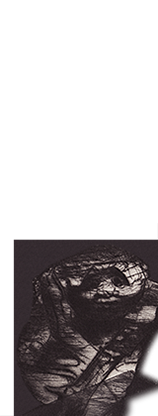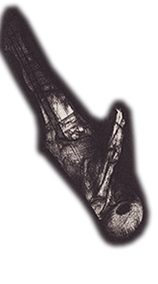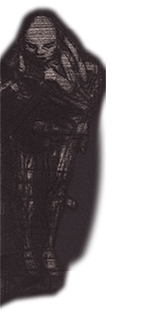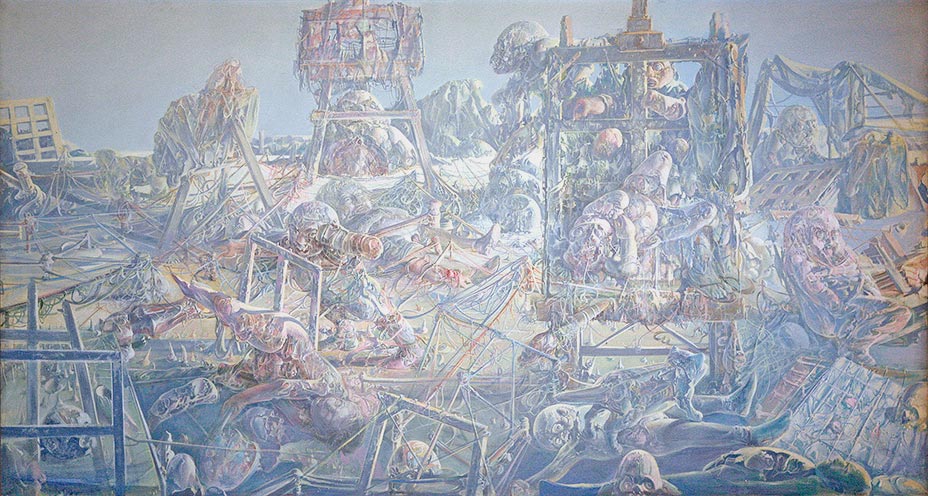Dado by Jean-Toussaint Desanti
The Obscene
or the Wiles of the Signifier
The text L’obscène ou les malices du signifiant by Jean-Toussaint Desanti initially appeared in October 1983 in number 29 of the review Traverses published by the Pompidou Center. At that time it was issued without an illustration of the Dado work it mentions, namely The Studio (1972, oil on canvas, 195 × 365 cm), here reproduced for the first time.
Photographs: Stéphane Rodier.
Click on the images to enlarge them
(large and extra large sizes)
❧
Fullscreen
slideshow
It is on record that the Latin obscenus is a word that comes from the language of augury: it designates a bad omen, a prediction of evil to come. It can be a flight of birds, chicken entrails, some bizarre event, indeed any occurrence from the wrong side. But first one has to agree on what the wrong side is: whatever comes from the left (sinister) can be favorable or unfavorable according to whether one looks to the south or north. From what side should one look? It’s the ritual that decides. The Etruscans looked south, the Greeks north. In any case, good omens come from the east. The side of night is negative: obscenus, it might be said.
Taken in this now forgotten sense the obscene is not an object one can look at. In any case, not just anyone: only the masters of the ritual have leisure to inspect it. The others, the common people, hurry past averting their gaze. They accelerate, eyes lowered: who knows what horror dwells within this accursed realm! Better not to look; leave it to the experts. That’s the refuge. No prying eyes. It’s dangerous to cross the border. It’s something that wards off the eye and yet exposes itself. It is what should remain secret and yet it expresses itself. Obscene thing; obscene word; obscene gesture. That’s the banal, everyday meaning given to obscenity today. How would it be if the acme of the obscene were, for example, to expose one’s backside from the rostrum at a philosophy symposium! An inoffensive incongruity it might be; save for one point: it violates the order of things, or, to put it differently, it disrupts the normal flow of the spectacle.
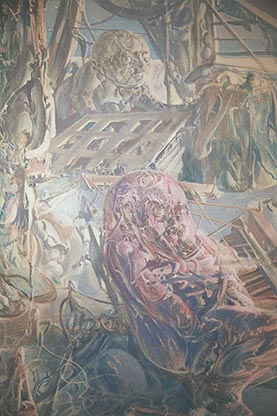
However, in its original, less diluted guise, obscenus harbors nothing ridiculous about it at all. On the contrary, the word indicates a highly disturbing entity, since it concerns the continuation and opening up of time.
Obscenus has disappeared from our horizon. Only the “obscene” remains. Are we then to give up it to derisory banality? On no account.
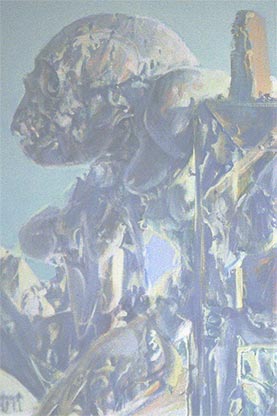
I read “obscene” and I hear “ob‑scene”. And when I hear “ob‑scene,” I feel I understand something of the long-forgotten meaning of “obscene.” That such a signification has been consigned to oblivion implies that common parlance conceals and betrays another meaning. The meaning is worrying enough to be hidden (or to require hiding). And it is perhaps the weight of this repressed meaning that makes me hear “ob‑scene” beneath “obscene,” and to take this chance homophony seriously. Why do I find it so hard to resist to this temptation, to the point that I find it quite natural to yield to it? In all probability because I have found by experience that the obscene harbors close links with the sense of sight, with how what is dissimulated can become visible. Think of a curtain rising; it might be a stage curtain, but it might be a veil concealing the truth about a body, sometimes a live body, sometimes a dead. Does the Obscene perhaps connote the unity between dissimulation and revelation? It is surely this aspect that requires investigating if one wants to gauge the burden of angst that coalesces around the word. Yes, this is a path worth exploring. And an example, a visual one at that, will help us proceed.
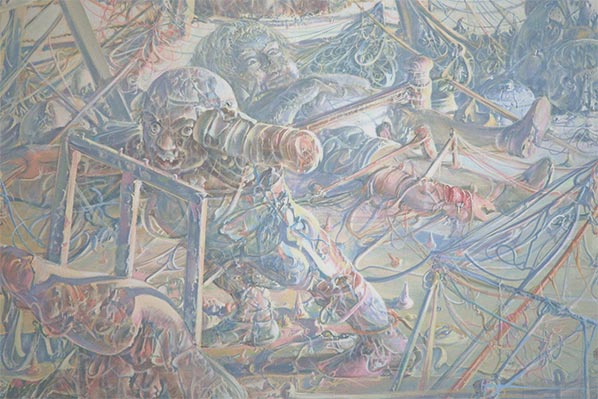
There’s a picture by Dado I often see: in fact every time I visit the friends in whose house it is. Chance – or could it be another of the “signifier’s” wiles – always puts me opposite it. It occupies more or less the entire expanse of one wall. As I write, I’m not looking at it. But it’s of little import since I have decided to let my mind drift – that is, to let myself be led by what I suspect is disruptive in the word “obscene.”
The first time I saw this picture, I had to shut my eyes. It hung in the dining-room at the time and I could hardly, without offending my friends, walk out. The fact though is that I didn’t want to be there. A similar desire to escape gripped me one morning before a painting by Bacon: I wanted to see it; but I couldn’t look at it. This is why I opened my eyes again and found myself being looked at by the painting. Looked at: that is designated, situated, warded off. This time, my eye was in thrall, as if something terrible and sacred, the invisible in the visible, had been drawn on the wall.
I understand now why, when I was asked to write on this theme (on the Obscene) and I fumbled about, unsure how to tackle it, it came to me all of a sudden on thinking of this picture. I had it in mind as a pointer to the strong sense of the obscene; probably simply because the first time I had seen it, I had fled without moving; rooted to the spot, if you like. However, I don’t believe in bad omens – or, to boot, in good ones. But something was being foretold on this wall: a disturbing and immense secret; on the canvas, something beyond the canvas orphaned my eyes, leaving them bereft and hapless.
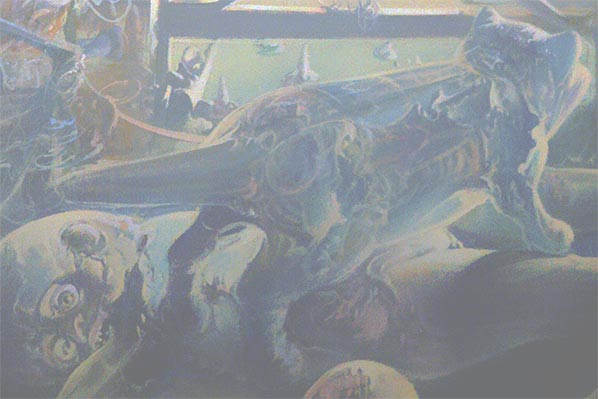
Then I started hunting for rats. For surely there were bound to be rats. There were too many dead bodies in this canvas, extenuated upon the rack; dead people with big heads, with a cyclopean, unseeing eye. The rats could not be far off, skulking in a corner, awaiting their turn at the feast. But rats were there none. Just a big animal with pointy ears, seen from the rear, side-on. Had it already half devoured some of the bodies whose entrails lay exposed, limbs torn off? No, it had not fed. The beast itself, though four-square on its legs, bore the telltale signs of death. Long deceased, from the beginning of time, perhaps, it was watching out for the dead.
And were they merely dead? They seemed to be fully conscious on their racks, their limbs in tatters, brandishing weapons of familiar shape, guns of a kind. Perhaps they had been waiting for an enemy for long time and it had never come. The wait had had the better of them; left to their own devices, now there was nobody to see them and recognize them in their world, swollen and mutilated as they were. But had they actually suffered mutilation? Had these guts ever belonged to the living? Was it because they had not that there were no rats (and yet I felt I had seen some, only for them to vanish when I got closer)? Was this why the animal had not yet dined? Perhaps it had always been dead, like all the others, on their racks, with their useless weapons. All these figures, with their severed limbs and gaping bellies, appeared of mineral clarity, but in an uncertain glow, a sulfurous air, without clouds. Perhaps it was the air that had corroded them. Whatever had happened must have done so quickly, and eons ago. An ill wind had surprised them in postures of defense. And now they lay dead exactly as they had lived: mineralized. Perhaps…, perhaps…
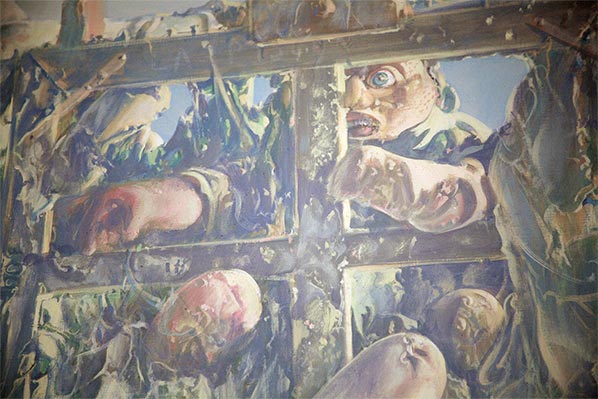
But if I forgather today some of the chimera that flitted through my mind at that time and ask: “But what was I trying to do by telling myself these stories?” I can but answer: “I was looking for the invisible something Dado had put up on the wall.” Symbolically, I sought “the rat,” which was not visible and would never be, but which existed in the form of the gnawing power of death. Every conceivable rat; that is, all the destructive elements a world can harbor appeared in this unyielding, all-encompassing, and unique form. They lurked in the Cyclops’ eye of these mineral entities, in the desolation of the timbers strewn about, behind the ears of this once ferocious beast, now motionless and corroded almost half away. Present too in the space delimited by the trestles that might just as well have been painter’s easels as torturer’s racks. And, just as sand precipitates out and settles at the bottom of the water, so death itself had settled in the gleam of this deserted world. A world according to death: this is what had to be stared at on this wall, a solid block, perfect in form and balanced in volume. This brings me back invincibly to the time I wanted to run away from Bacon’s painting: for it too showed, in a single living body, all possible dead bodies.
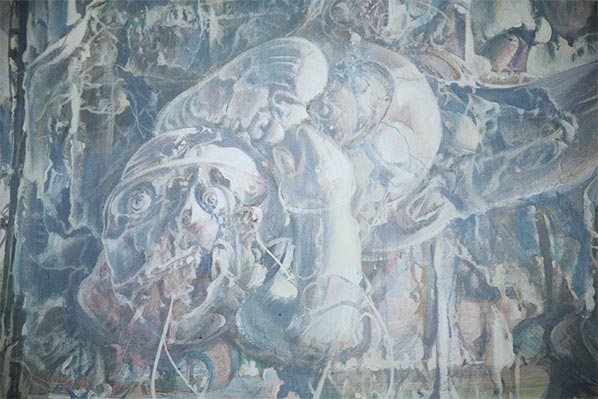
Thus can art, in certain cases, make a deeply ethical impact. That is, it can make us think long and hard about the status and consistency of the visible, reduced, so to speak, to its unfathomable obverse. To peer into the core of the picture to see the wrong side of things in their right side is neither particularly commonplace nor particularly reassuring.
Yet this ethical effect is not enough to produce the effect of obscenity. I suspect something is still missing from my analysis. A clue came in the fundamental difference between, in my eyes, Bacon and Dado, although each in his own manner rebuffs an eye uneasy in the gaze that gazes out of the canvas… It seems to me that I’d never go to a picture by Bacon to hunt for the symbolic rat, in spite of the tortured flesh and whirling bodies it proffers. There is not the place: there is no room for the “rat.” Why? Well surely because, within the space of the canvas, there’s no unfilled space. The space is closed in on itself: every gap, every void, produces a very different sense of enclosure. The anguish engendered by the vision of an enclosed space, one that encompasses death and which looks out at you, might produce tragedy, but not the obscene. The situation in the Dado is quite distinct. I’m not speaking here about his “facture.” It exudes balance, it is “well composed,” consummate, if you will. But what it consummates is incompletion. Each point in the space, far from closing in on itself, opens out onto some indefinable beyond whence it appears to emerge in bewildering superabundance (qv. the disproportionately large heads of the mineral Cyclops). A centrifugal effect which, as it bedazzles the eye, drives it out towards somewhere else, to some place not in the canvas.
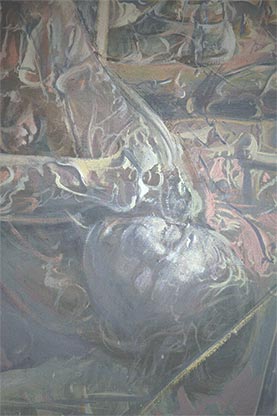
“Obscene” then: a superabundance of being that foretells of Nothingness, and which – while refusing to be confined within the limits of the visible, – expands invasively to occupy every visible place. This is why, in one and the same movement, the obscene both seizes the eye and repels it. This is nothing to do then with a sundry display of genitalia. A painter friend ¹ with whom I talked to about this said that for her the most obscene picture was the Miracle of the Holy Thorn. Surely because the people in it are, like those in the Dado, neither entirely alive nor entirely dead – or perhaps they have always been dead.
Painting is decidedly not a placid art. It still bears within it the traces of all it conveys, since the very beginning, of the sacred and the forbidden.
1. Françoise Gilot.
Translated from French by D. Radzinowicz
